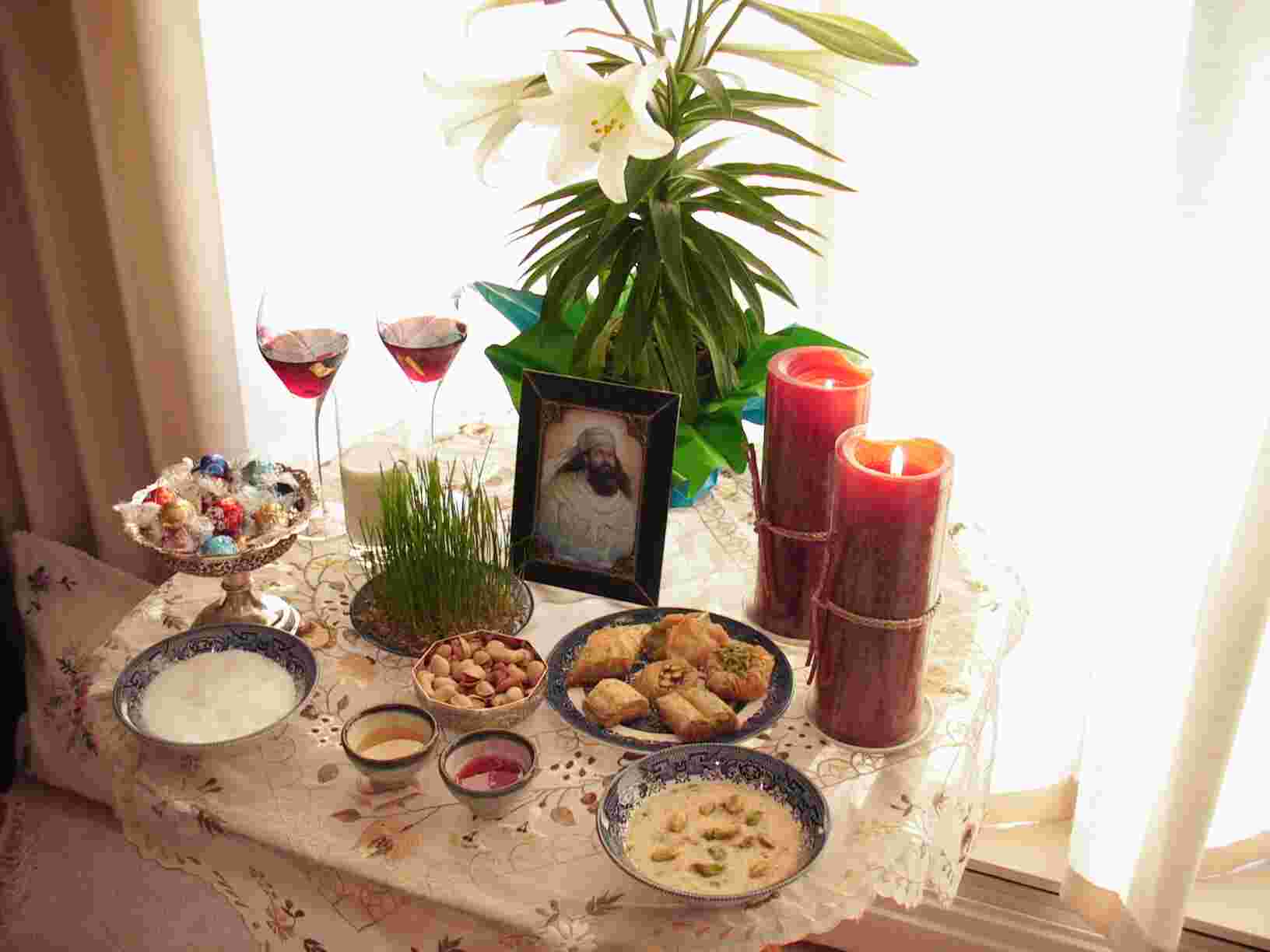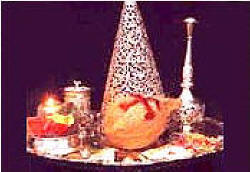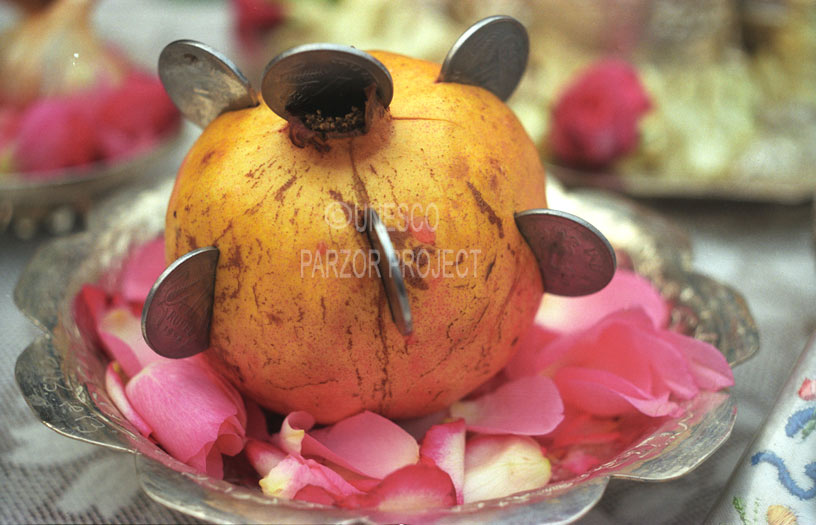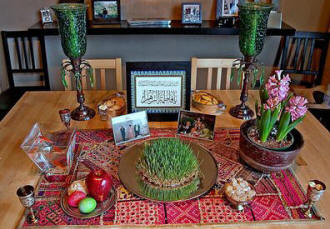
Image credit: Mahmoud Farschian
Contents
Nowruz (New Year)
Introduction
Pre-Nowruz Festivities and Observances
Nowruz Day Customs & Observances
» Page 1: Introduction
» Page 2: Pre-Nowruz Festivities and Observances
Nowruz Customs - The Nowruz Spread or Sofreh
 |
| Traditional Iranian family facing a Nowruz sofreh |
The Nowruz spread is to Nowruz, what a Christmas tree is to Christmas. Nowadays, the spread or sofreh is placed on a table. Traditionally, the sofreh was spread on the floor. There are other kinds of sofrehs such as sofreh aghd, or wedding spread (that are placed on the floor).
 |
| Priest performing a thanksgiving or Jashan ceremony on a sofreh |
Customarily, all Zoroastrian religious ceremonies are conducted on a sofreh spread on the floor using white linen. An example is a jashan or thanksgiving ceremony being performed by a priest shown here on the left. Sitting on the floor has other symbolisms for Zoroastrians: it is a mark of humility and it keeps one grounded in more ways than one. Staying in contact with the floor brings a person closer to the earth, literally and figuratively.
There are three kinds of items placed on a sofreh: items that have symbolic value for the occasion (in this case Nowruz), items common to occasions such as a sace (see below), and items that householders feel represent core beliefs or which have special significance to them.
A Nowruz sofreh is unique to a home and can become quite creative. Nowruz sofrehs in Zoroastrian homes are usually somewhat different from non-Zoroastrian households.
The Nowruz Spread or Sofreh in Zoroastrian Homes

|
| Nowruz table at this writer's home |
The Nowruz spread (sofreh in Persian) in Zoroastrian homes has seven (haft in Persian) items beginning with the letter "sh" or "sheen". Therefore it called a haft-sheen spread or table. The seven items are:
- Sharab or wine
- Shakar or sugar
- Shir or milk
- Shireh or syrup
- Shahd or honey
- Shirini or candy
- Shir-berenj or rice-pudding (recipe)
(If you run your computer mouse over the photograph above-right, the haft sheen items will be identified by a pop-up tag. Two items have links, one to the pudding recipe, and the other for how to grow sprouts.)
The number seven represents:
- God and God's six abstract attributes or archangels.
- The seven aspects of temporal creation: fire, air, water, earth, plants, animals and human beings.
- The seven ethical concepts: a good mind and wisdom, truthfulness and righteous deeds, self-reliance and autonomy, peace and serenity, wholeness and excellence, perseverance and steadfastness.
- The seven acts of piety: generosity of the spirit and speaking well of others, material generosity and sharing, selfless help towards those in need, community participation and inclusion (through supporting the gahambars), honesty, piety, remembrance of the souls (specifically the fravashis) of the righteous and one's ancestors.
- The seven features of Nowruz: renewed and reaffirmed commitment to personal goals grounded in goodness, renewed energy and a positive cheerful disposition, renewed positive relationships, cleanliness and good health, honour and care for the environment, and preserving the eternal spiritual flame.

|
| Another example of an Haft Seen table in a Zoroastrian home |
Given that 'sharab' meaning wine is an Arabic word, and that the names of the alphabets 'sheen' for 'sh' and 'seen' for 's' are of Arabic origin as well, the entire tradition that identifies the items based on the first alphabet, it could be that the entire tradition of the seven items beginning with an particular letter originated after the Arab conquest of Iran. It could also be that the use of wine was a silent protest against the culture imposed by the Arabs. The authentic items to be placed on the tray based on Zoroastrian tradition are those representing the seven Amesha Spentas. This symbolism is followed in during a
Jashne/Jashan ceremony.
Additional items that are frequently seen on the Nowruz spread are a book of scripture, a portrait of Zarathushtra, a mirror, rose-water, candles or oil lamps, a fire chalice, a fish bowl containing gold fish, sprouted wheat or greens, various grains, flowers, fruits, coins, bread, a cone made from sugar, and painted boiled eggs similar to Easter eggs.

|
| A sace |
Some households place a sace or ses on the Nowruz table. A sace (seen here on the right) consists of a metallic tray, made from stainless steel, EPNS (German silver) or silver, and matching accessories such as a fire chalice or oil lamp, a container with a long neck for rose water, and a cone for rock-sugar. The sace and its accessories can be exquisitely crafted and are often part of a family heirloom.
 |
| Haft-seen table |
An important part of the Nowruz table is a source of fire: a fire chalice, candles or an oil lamp. Fire represents core Zoroastrian values based on goodness and honesty (similar to the Olympic flame).
The sofreh is a white table-cloth or linen sheet, white being the Zoroastrian symbol for purity. The other items represent the bounty of creation and the joy of a good, meaningful life.
 |
| Pomegranate with inserted coins |
The occasional spread may even contain a pomegranate fruit with coins inserted as a symbol for prosperity, longevity and good health in the New Year (see photo on the right). The pomegranate tree and its fruit have special significance in Zoroastrian rituals and ancient health practices. (For more information, see our pages on Haoma and the Baresman.)
The Nowruz Spread or Sofreh in Islamic Homes
Since Muslims are not permitted to drink wine, they adapted the sofreh to a haft-seen sofreh, one that has seven items beginning with the letter "s" or "seen":
- serkeh or vinegar
- sumac
- sir or garlic
- samanu a sweet paste or halwa
- seeb or apple
- senjed or sorb-tree berry
- sabzi or green herbs
While hyacinths (sonbol) and coins (sekkeh) are popular display items that begin with "s", they are not traditionally considered part of the seven.
|
Nowruz Day Customs and Foods
Orthodox Zoroastrians will rise, bathe and say their prayers before dawn, since this is the time to bid farewell to the fravashis, the souls, who have joined in the festivities of the Hamaspathmaidyem Gahambar.
On Nowruz day, after bathing, members of the family dressed in new clothes gather around the table at the behest of the matriarch of a Zoroastrian home.
Greeting are exchanged after which the matriarch holds up a mirror and each person (and later, visitors) look into the mirror and smile. The mirror reflects a person's past, shows the present and reminds a person to reflect on future goals and pledges. In Zoroastrian theology, the soul receives a reflection of a person's thoughts, words and deeds - "as you sow, so shall you receive".
The festivities include elder members of the household giving younger members gifts.
Breakfast can include sweet dishes such as faloodeh (or falooda), ravo, and a dish made from fried vermicelli cooked in sugar preparation and decorated with dry fruits. These dishes are more the norm amongst Zoroastrians from India.
 |
| Faloodeh strands |
Faloodeh (see recipe with homemade ingredients & recipe with store-bought ingredients) in Iran is served thoroughly chilled in a bowl and looks like vermicelli-like white strands soaked in rose syrup or a sweet sharbat (sherbet).
 |
| Glass of Falooda |
In India, the Zoroastrian-Irani diners have transformed faloodeh into a milk shake topped with a scoop of vanilla ice-cream. There it is called falooda
(see recipe with homemade ingredients & recipe with store-bought ingredients).
Ravo is made with suji (semolina - a coarsely ground and highly glutinous hard durum wheat), milk and sugar. It is prepared and looks like a thick porridge.
A Nowruz lunch according to Indian Zoroastrian tradition includes pulav, rice with nuts and saffron, moong dal and fish, a dishes with similarities to the Iranian meal of Sabzi Polo Mahi.
 |
| Sabzi Polo Mahi |
In Iran, some traditional Nowruz foods have good luck wishes for the New Year associated with them. The dishes include:
• Sabzi Polo Mahi: (See photo to the right) Rice with green herbs served with fish. The seasonings used are parsley, coriander, chives, dill and fenugreek.
 |
| Kookoo Sabzi |
• Kookoo Sabzi: (See photo to the left) This is a light and fluffy omelette soufflé made from parsley, dill, coriander, spinach, spring onion ends and chives, mixed with eggs and walnut. Kookoo Sabzi is served at dinner on Nowruz evening.
• Reshteh Polo: Rice cooked with noodles. This dish is associated with the wish of success in life.
• Dolme Barg: Similar to the Greek dolmades, dolmes are a mixture of cooked vegetables, meat and rice wrapped vine leaves and cooked again. This dish is associated with the wish of fulfilment of hopes and dreams.
Nowruz Prayers
 |
| Zoroastrian Priest performing a jashan ceremony |
After breakfast and after family customs and ceremonies have been observed, the religious minded visit a temple to pray.
Zoroastrian pray individually unless they participate in a special thanksgiving ceremony, called a jashan ceremony, led by a priest or priests.
Individuals prayers may include the patet, repentance in a self-appraisal for less than stellar thoughts, words and deeds during the past year, and in so doing prepare for a commitment for future goodness in a spiritually cleansed state. The patet is followed by thanksgiving and a commitment to a chosen path for the year and years to come. (Click here for a patet prayer.)
Families may invite or sponsor a thanksgiving or jashan ceremony performed a priest or priests at their home or in the temple.
Socializing
 |
| Visiting elders in a traditional Iranian home |
Visits between households start on Nowruz day with visits between close family members and continue in the days following Nowruz to include close friends as well as community elders.
In Iran, some families let others know which day they will be at home and the greeting of guests as well as the refreshments served, follow a tradition called taurouf, a word which integrates formal etiquette and service.
In India, Zoroastrian families welcome guests with a sprinkling of rose water and a visit to the Nowruz table where the matriarch may hold up a mirror and invoke a smile from her guests. This simple ritual may be performed at a designated spot decorated with stamped powdered chalk designs sometimes called chuna or rangoli. The rituals add to the joyous nature of the occasion.
The Outdoors and Sizdah-Bedar
 |
| Sizdah Bedar spending the day outdoors |
The Nowruz holidays are a time for picnicking and outdoor excursions. The picnics and excursions are made to the countryside, parks and country homes. This is especially true for the last day of the festivities - the thirteenth day after Nowruz - a day called Sizdah-be-dar literally translated as "thirteen-outside-door" or out-of-doors-on-the-thirteenth.
The concluding Nowruz customs are the removal of the Nowruz table decorations on the thirteenth day, Sizdeh-Bedar, and spending the day out-of-doors. After the Nowruz spread is disassembled, the sprouts grown for the table are thrown into a moving river. Some unmarried girls tie knots out of the sprouts and wish for good fortune and success in finding the love of their life.
While the superstitious may associate the 13th day with bad luck, there is no such notion in Zoroastrian traditions. Perhaps the myth that it is unlucky to stay at home on the thirteenth was created to give the house-bound added incentive to leave their homes and appreciate the spring-time unveiling of nature's beauty.
In the Zoroastrian calendar, Sizdah-be-dar falls on Tir (the 13th) day in the month of Farvardin, April 2. The name Tir is a modern and short form of the Middle Persian (Pahlavi) Tishtar and Avestan Tishtrya, the Zoroastrian Avestan name for the brightest star Sirius as well as the guardian angel of rain and rain water. Zoroastrians therefore make a special effort to spend the day beside a river or a lake. The devout will recite passages from the Tir Yasht.
For Zoroastrians, this day also celebrates the unfolding bounty of nature and life (gaya). Sizdah Bedar provides an opportunity for Zoroastrians to enjoy what nature has to offer while renewing their covenant to protect or enhance the environment, and not defile any of the seven aspects of the corporeal creation (gaiety): fire, air, water, earth, plants, animals and human beings.
As the sun sets, the Nowruz festivities draw to a close.
» Top
» Page 1: Introduction
» Page 2: Pre-Nowruz Festivities and Observances

